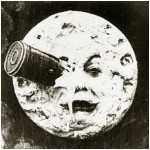
In 1902, Georges Melies wrote and produced the first science fiction film, Le Voyage dans la Lune (The Voyage to the Moon). This 14-minute silent film inspired by the stories of Jules Verne and H.G. Wells involves a group of men who arrive on the moon (in the moon’s eye, to be exact) via a rocket shot out of a cannon. Despite the humans’ ability to disintegrate the indigenous moon creatures with their umbrellas, they’re captured and brought to the moon king. Eventually they end up killing the moon leader, and then they fall off the side of the moon and successfully “land” the rocket in the ocean.
Yeah, you read that right. But hey, it was 1902! And that’s almost certainly not the least feasible plot turn imaginable.
What Melies, Wells, and Verne started, countless writers such as Heinlein, Clarke, Asimov, and LeGuin have continued. The idea of someone or something living on the moon gave way to stories about human colonies on the moon, and even though the moon may lose a little luster next to our recent space explorations and discoveries, neither science fiction nor science is ready to let go of the idea.
Enter the 3-D printer. Yes, it can make pastries, burritos, and possibly meat. It’s likely that someday, we will be able to print bones and organs. But a professor at the University of Southern California believes 3-D printers can produce much bigger things right in the eye of the moon.
NASA’s Innovative Advanced Concepts division has awarded a $500,000 grant for the development of a technology called Contour Crafting that will help build permanent structures and settlements on the moon.
Contour Crafting uses a layering technique similar to that of 3-D printing, but instead of a print box, Contour Crafting uses an electrically-power, computer-controlled crane for construction. This allows for production on a much larger scale than a 3-D printer; Contour Crafting technology would use a material similar to concrete to build a lunar base, roads, platforms, shields, and other structures.
Current 3-D printing technology is notoriously slow, and can take hours to print small objects. One of the goals of Contour Crafting is speed; it may be possible for this technology to produce a home in about a day without any manual labor. This technology also wouldn’t release the fumes or generate the waste normally associated with construction.
The most difficult and expensive detail would be the transportation of the components, which is currently estimated to cost roughly $100,000 per kilo. Perhaps we can 3-D print some extra dough.
While bringing this concept to fruition might take decades, some moon inhabitants are already waiting excitedly for humans, ready to steal playthings of extraordinary magnitude. Better guard that crane (and your Foreigner belt!)



They’re totally forming quad-laser in anticipation of our building projects…
Pingback: National Park On The Moon Proposed (Yosemite Is So Passé) | Giant Freakin Robot